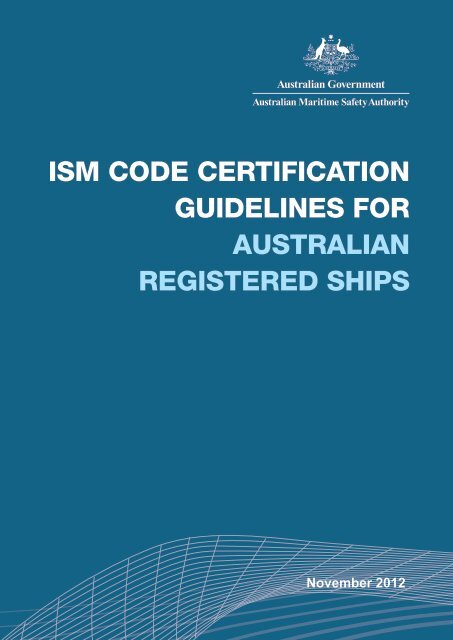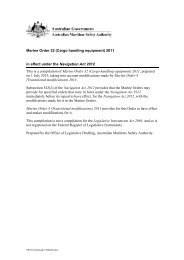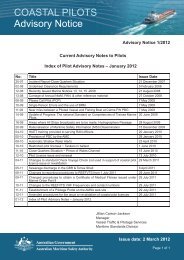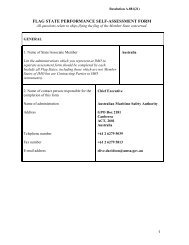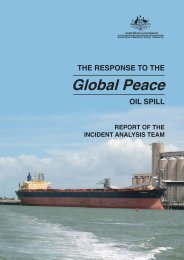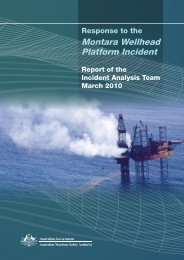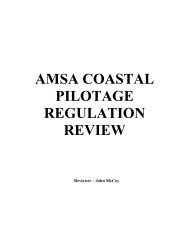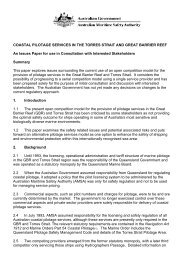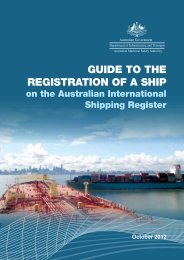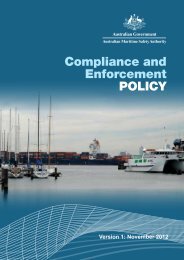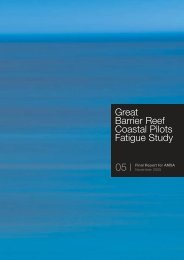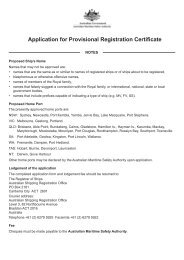ISM Code Certification - Australian Maritime Safety Authority
ISM Code Certification - Australian Maritime Safety Authority
ISM Code Certification - Australian Maritime Safety Authority
Create successful ePaper yourself
Turn your PDF publications into a flip-book with our unique Google optimized e-Paper software.
<strong>ISM</strong> CODE CERTIFICATION<br />
GUIDELINES FOR<br />
AUSTRALIAN<br />
REGISTERED SHIPS<br />
November 2012
<strong>ISM</strong> <strong>Code</strong> <strong>Certification</strong> Guidelines for<br />
<strong>Australian</strong> Registered Ships<br />
Definitions<br />
The following definitions relate to terms used specifically in this document.<br />
Where it is not specified in these Guidelines, definitions are as per <strong>ISM</strong> <strong>Code</strong> and as specified in the<br />
associated documents.<br />
Administration<br />
means the Government of the State whose flag the ship is entitled to fly. In these Guidelines, the<br />
Administration is the <strong>Australian</strong> <strong>Maritime</strong> <strong>Safety</strong> <strong>Authority</strong>, unless otherwise stated.<br />
GM, SSD<br />
means the AMSA General Manager, <strong>Maritime</strong> Operations Division.<br />
Manager<br />
means the AMSA Manager of Ship Operations and Qualifications, <strong>Maritime</strong> Operations Division.<br />
AMSA <strong>ISM</strong> <strong>Code</strong> Auditor (Auditor)<br />
an AMSA Marine Surveyor who has been appointed by the Manager as <strong>ISM</strong> <strong>Code</strong> Auditor, and who has<br />
undergone initial training and ongoing participation with <strong>ISM</strong> <strong>Code</strong> related activities specified in Annex D.<br />
AMSA <strong>ISM</strong> <strong>Code</strong> Lead Auditor (Lead Auditor)<br />
an AMSA <strong>ISM</strong> <strong>Code</strong> Auditor in charge of an audit team. Where there is only one auditor in an audit, then<br />
this auditor will be the Lead Auditor.<br />
AMSA <strong>ISM</strong> <strong>Code</strong> Coordinator<br />
is an AMSA <strong>ISM</strong> <strong>Code</strong> Auditor who has been appointed by the General Manager, <strong>Maritime</strong> Operations<br />
Division (GM, SSD).<br />
Audit<br />
is part of the <strong>ISM</strong> <strong>Code</strong> certification process by the Administration to verify and determine if a safety<br />
management system complies with the objectives and requirements of the <strong>ISM</strong> <strong>Code</strong>.<br />
Company<br />
means the owner of the ship, or any other organisation or person such as the ship manager or bareboat<br />
charterer, who has assumed the responsibility for operation of the ship from the shipowner and who, on<br />
assuming such responsibility, has agreed to take over all duties and responsibilities imposed by the <strong>ISM</strong><br />
<strong>Code</strong>.<br />
Document of Compliance (DOC)<br />
is a form of certificate (Provision 9 of MO 58) issued to a Company which operates a functional safety<br />
management system complying and satisfying with the requirements of the <strong>ISM</strong> <strong>Code</strong> certification process<br />
established by the Administration.<br />
i
<strong>ISM</strong> <strong>Code</strong> <strong>Certification</strong> Guidelines for<br />
<strong>Australian</strong> Registered Ships<br />
<strong>Safety</strong> Management Certificate (SMC)<br />
is a form of certificate (Provision 10 of MO 58) issued to a Ship which is operated by a Company holding<br />
a valid DOC certificate issued by the Administration and that the shipboard safety management system<br />
complies and satisfies with the requirements of the <strong>ISM</strong> <strong>Code</strong> certification process established by the<br />
Administration.<br />
International <strong>Safety</strong> Management <strong>Code</strong> (<strong>ISM</strong> <strong>Code</strong>)<br />
means the International Management <strong>Code</strong> for the Safe Operation of Ships and for Pollution Prevention<br />
(International <strong>Safety</strong> Management <strong>Code</strong>), set out in IMO Resolution A.741(18) and Chapter IX, SOLAS,<br />
1974, as amended).<br />
Objective Evidence<br />
means quantitative or qualitative information, records or statements of fact pertaining to safety or to the<br />
existence and implementation of a SMS element, which is based on observation, measurement or test and<br />
which can be verified.<br />
Observation<br />
means a statement of fact made during a safety management audit and substantiated by objective<br />
evidence.<br />
Non-conformity or Minor Non-conformity (NC)<br />
means an observed situation where objective evidence indicates a non fulfilment of a specified requirement.<br />
Unless specified otherwise, a non-conformity is not a major non-conformity and may be referred to as a<br />
minor non-conformity.<br />
Major Non-conformity<br />
means an identifiable deviation that poses a serious threat to personnel or the ship or serious risk to the<br />
environment and requires immediate corrective action or a lack of effective and systematic implementation<br />
of a requirement of the <strong>ISM</strong> <strong>Code</strong>.<br />
Corrective Action Plan (CAP)<br />
means the response by the Company to address a non conformity that should include a root cause analysis<br />
of the non-conformity, proposed corrective action(s), including measures intended to prevent recurrence,<br />
and targeted completion date(s) for review and acceptance by the Lead Auditor.<br />
ii
<strong>ISM</strong> <strong>Code</strong> <strong>Certification</strong> Guidelines for<br />
<strong>Australian</strong> Registered Ships<br />
Associated documents<br />
• Marine Orders Part 58<br />
• International <strong>Safety</strong> Management (<strong>ISM</strong>) <strong>Code</strong><br />
• SOLAS Chapter IX – Management for the Safe Operation of Ships<br />
• IMO Resolution A.714(18) – International Management <strong>Code</strong> for the Safe Operation of Ships and for<br />
Pollution Prevention (<strong>ISM</strong> <strong>Code</strong>)<br />
• IMO Resolution MSC.273(85) – Adoption of Amendments to the <strong>ISM</strong> <strong>Code</strong><br />
• IMO Resolution A.1022(26) - Guidelines on implementation of <strong>ISM</strong> <strong>Code</strong> by Administration<br />
• IMO MSC-MEPC.7/Circ.5 - Guidelines for the Operational Implementation of the <strong>ISM</strong> <strong>Code</strong> by<br />
Companies<br />
• IMO MSC-MEPC.7/Circ.6 – Guidance on the Qualifications, Training and Experience necessary for<br />
undertaking the role of the Designated Person under the provisions of the <strong>ISM</strong> <strong>Code</strong><br />
• ICS / ISF Guidelines on the application of the IMO International <strong>Safety</strong> Management <strong>ISM</strong>) <strong>Code</strong><br />
iii
<strong>ISM</strong> <strong>Code</strong> <strong>Certification</strong> Guidelines for<br />
<strong>Australian</strong> Registered Ships<br />
Contents<br />
Defintions.............................................................................................................i<br />
Associated Documents...................................................................................... iii<br />
1.. Application of the <strong>ISM</strong> <strong>Code</strong>..........................................................................3<br />
2.. Responsibilities of AMSA <strong>ISM</strong> <strong>Code</strong> Personnel............................................3<br />
3.. AMSA <strong>ISM</strong> <strong>Code</strong> <strong>Certification</strong> Process.........................................................4<br />
1.. General...................................................................................................4<br />
2. <strong>ISM</strong> <strong>Code</strong> <strong>Certification</strong>............................................................................5<br />
3. Interim Doc and SMC.............................................................................6<br />
4. Full Term Doc and SMC..........................................................................6<br />
5. Annual Endorsement of Doc and Intermediate Endorsement of SMC....7<br />
6. Company with Branch Offices................................................................8<br />
7. Notes on FPSO and FSO.......................................................................8<br />
8. Audit Reports, Non-conformance Notes and Corrective Actions............9<br />
9. Withdrawal and Variation of <strong>ISM</strong> <strong>Code</strong> Certificates..............................10<br />
10. Conduct of Joint <strong>ISM</strong> COde Audits between AMSA and AMSA<br />
Approved Organisations.......................................................................10<br />
11. Recognition of Overseas Documents of Compliance issued to<br />
Overseas Companies operating <strong>Australian</strong> Flag Ships........................ 11<br />
12. <strong>Australian</strong> Flag Ships Detained Overseas............................................11<br />
13. Conduct of Shipboard Verification Audits of <strong>Australian</strong> Flagged Ships<br />
Overseas..............................................................................................12<br />
14. Review of Decisions.............................................................................13<br />
15. Fees and Costs.....................................................................................13<br />
16. DPA Workshops....................................................................................13<br />
1
2<br />
<strong>ISM</strong> <strong>Code</strong> <strong>Certification</strong> Guidelines for<br />
<strong>Australian</strong> Registered Ships
<strong>ISM</strong> <strong>Code</strong> <strong>Certification</strong> Guidelines for<br />
<strong>Australian</strong> Registered Ships<br />
1. Application of the <strong>ISM</strong> <strong>Code</strong><br />
1. In accordance with SOLAS Chapter IX, MO 58 applies to all Convention ships<br />
regardless of the date of construction, as follows:<br />
a. all passenger ships, including passenger high-speed crafts;<br />
b. all cargo ships, including cargo high-speed crafts, of 500 GRT or more;<br />
c. mobile offshore drilling units propelled by mechanical means of 500 GRT<br />
or more,<br />
d. and to any company owning, operating or managing such a ship or unit.<br />
2. The <strong>ISM</strong> <strong>Code</strong> does not apply to government-operated ships or ships used<br />
for non-commercial purposes.<br />
2. Responsibilities of AMSA <strong>ISM</strong> <strong>Code</strong> Personnel<br />
1. The Manager is responsible for the following:<br />
a. oversees the management of AMSA <strong>ISM</strong> <strong>Code</strong> <strong>Certification</strong> process;<br />
b. approves AMSA <strong>ISM</strong> <strong>Code</strong> Certificate process, including these<br />
Guidelines;<br />
c. approves requests for initial <strong>ISM</strong> <strong>Code</strong> certification;<br />
d. issues DOC and SMC;<br />
e. appoints AMSA <strong>ISM</strong> <strong>Code</strong> Auditor;<br />
f. recommends withdrawal or variation of DOC and SMC;<br />
g. resolves disputes related to certification decision and fee charges; and<br />
h. approves allocation of funding for maintenance of AMSA <strong>ISM</strong> <strong>Code</strong><br />
certification process, including auditor training.<br />
2. The <strong>ISM</strong> <strong>Code</strong> Coordinator is responsible for the following:<br />
a. the management of AMSA <strong>ISM</strong> <strong>Code</strong> <strong>Certification</strong> process;<br />
b. reviews and implements AMSA <strong>ISM</strong> <strong>Code</strong> Certificate process;<br />
c. reviews and recommends changes to these Guidelines and related<br />
documents;<br />
d. reviews and recommends requests for initial <strong>ISM</strong> <strong>Code</strong> certification;<br />
e. reviews the issue of full term DOC and SMC and presents to the Manager<br />
for approval and signature;<br />
f. reviews request for audit from Companies and liaise with AMSA Regional<br />
Managers to assign attending auditors;<br />
g. oversees <strong>ISM</strong> <strong>Code</strong> records are maintained as per AMSA standards;<br />
3
<strong>ISM</strong> <strong>Code</strong> <strong>Certification</strong> Guidelines for<br />
<strong>Australian</strong> Registered Ships<br />
h. manages training and assessment of auditors;<br />
i. reviews audit reports before distribution to Companies;<br />
j. reviews disputes and makes appropriate recommendations to the<br />
Manager;<br />
k. liaises with the marine industry in complying with AMSA <strong>ISM</strong> code<br />
requirements; and<br />
l. assumes the job responsibility as Auditor when required.<br />
3. The <strong>ISM</strong> <strong>Code</strong> Auditor is responsible for the following:<br />
a. the planning and conduct of audits as per AMSA <strong>ISM</strong> <strong>Code</strong> certification<br />
process;<br />
b. reviews Company SMS manuals for DOC or SMC audit;<br />
c. submits completed audit report to <strong>ISM</strong> Coordinator for review and<br />
distribution;<br />
d. consolidates fees charges and expenses for Regional Manager to review;<br />
e. review and accept corrective action plans submitted by Company;<br />
f. verifies close-out of NCN;<br />
g. recommends issue or withdrawal of DOC or SMC;<br />
h. endorses DOC or SMC for applicable annual, intermediate and additional<br />
verification after completion of an audit in accordance with AMSA<br />
standards;<br />
i. liaises with local marine industry to comply with AMSA <strong>ISM</strong> code<br />
requirements;<br />
j. maintains own audit records;<br />
k. participates in auditor training and qualification requirements; and<br />
l. acts as Lead Auditor when required.<br />
3. AMSA <strong>ISM</strong> <strong>Code</strong> <strong>Certification</strong> Process<br />
1. General<br />
a. A Company should apply for issue of a Document of Compliance<br />
in writing to the <strong>ISM</strong> Coordinator. The Coordinator will review the<br />
application and liaise with the Company to discuss Company particulars,<br />
the scope of certification, SMS review requirements, audit timelines and<br />
fees.<br />
b. Once the application had been approved by the Manager, the Company<br />
should submit its SMS manual(s) to the <strong>ISM</strong> Coordinator for review and<br />
arrange for an audit.<br />
4
<strong>ISM</strong> <strong>Code</strong> <strong>Certification</strong> Guidelines for<br />
<strong>Australian</strong> Registered Ships<br />
c. Subsequent to the issue of DOC certificate by AMSA, the Company<br />
should apply for <strong>Safety</strong> Management Certificate(s) for its ship(s), as<br />
mandated by SOLAS Chapter IX/Reg.2 and MO 58/Prov.4, by submitting<br />
an application in writing to the <strong>ISM</strong> Coordinator.<br />
d. For either the Company or Shipboard verification audit, the <strong>ISM</strong><br />
Coordinator will liaise with the appropriate SSD Regional Manager and<br />
<strong>ISM</strong> Auditors to nominate a Lead Auditor to take charge of the audit. The<br />
Lead Auditor will liaise with the Company to finalise audit location, dates,<br />
schedule and settlement of costs in accordance with AMSA standards.<br />
e. Audits will be conducted, reported and recorded / filed in accordance<br />
with AMSA standards.<br />
2. <strong>ISM</strong> <strong>Code</strong> <strong>Certification</strong> – Document of Compliance (DOC) and <strong>Safety</strong><br />
Management Certificate (SMC)<br />
a. A DOC may be issued to a Company, and an SMC may be issued to a<br />
Ship operated by a Company possessing a valid DOC, when AMSA has<br />
verified the effectiveness of the Company SMS in meeting the specified<br />
objectives defined in paragraph 1.2.3 of the <strong>ISM</strong> <strong>Code</strong>.<br />
b. A DOC will be issued only for the IMO ship types on which the audit was<br />
based. The list of applicable ship types will be indicated on the DOC.<br />
The scope of the DOC may be amended (through issue of a new DOC) to<br />
cover additional ship types after an audit of the Company’s capability to<br />
comply with the requirements of <strong>ISM</strong> <strong>Code</strong> with respect to the additional<br />
ship type.<br />
c. A full term SMC will not be issued to a ship if:<br />
i. the Company DOC is only interim, or ii the Company DOC is not<br />
valid, or<br />
ii.<br />
the Ship is suspended or cancelled by the respective Class Society,<br />
such as overdue Class periodical survey, overdue condition of class,<br />
etc., or<br />
iii. a Ship statutory certificate is not valid, such as overdue mandatory<br />
survey, etc., or<br />
iv. any unresolved major non-conformity note issued by AMSA to the<br />
Company or the Ship exists.<br />
d. A DOC or SMC will not be issued, endorsed or renewed if an unresolved<br />
major non-conformity exists. A major non-conformity note issued to the<br />
Company or the ship must be downgraded to minor non-conformity<br />
and any identified serious risks or threats to personnel or ship or the<br />
environment must be removed or reduced to an acceptable level.<br />
e. Depending on the number and severity of non-conformities, the Lead<br />
Auditor may consider an additional verification audit to verify the<br />
completion of the corrective and preventative action.<br />
5
<strong>ISM</strong> <strong>Code</strong> <strong>Certification</strong> Guidelines for<br />
<strong>Australian</strong> Registered Ships<br />
3. Interim DOC and SMC<br />
a. Interim DOC and SMC will be issued to a Company or Ship in<br />
accordance with the <strong>ISM</strong> <strong>Code</strong> and MO 58.<br />
b. An Interim DOC should be valid for 12 months. There is no provision to<br />
extend an Interim DOC in <strong>ISM</strong> <strong>Code</strong> or MO 58. An Interim SMC should<br />
be valid for 6 months and under special circumstances, as approved by<br />
the Manager, the Interim SMC may be extended for a further 6 months.<br />
c. The Lead Auditor will recommend the issue of an Interim DOC or SMC<br />
upon satisfactory completion of an interim assessment.<br />
d. The Lead Auditor will contact the <strong>ISM</strong> Coordinator for issue of the Interim<br />
DOC or SMC by the Manager. In cases where the Company needs the<br />
Interim DOC or SMC immediately after the assessment, the interim DOC<br />
or SMC may be issued by the Manager prior to the assessment.<br />
4. Full Term DOC and SMC (INITIAL and RENEWAL)<br />
a. A full term DOC or SMC will be issued by the Manager, on the<br />
recommendation of the Lead Auditor and verification by the <strong>ISM</strong><br />
Coordinator of the audit report, following closure of non-conformities<br />
identified during the audit.<br />
b. The period of validity of a full term DOC or SMC will be five (5) years,<br />
subject to the annual verification audit carried out within three (3) months<br />
before or after the initial verification audit date or, in the case of SMC,<br />
subject to the intermediate verification audit carried out between the<br />
second and third anniversary after the initial verification audit date. The<br />
expiry date of the DOC or SMC will be five (5) years, minus one (1) day,<br />
after the initial verification audit date.<br />
c. A new full term DOC or SMC issued after a renewal audit will have the<br />
same expiry date as the existing full term DOC or SMC, plus five (5)<br />
years, provided the renewal audit is completed within three (3) months<br />
prior to the original expiry date of the certificate. When the renewal audit<br />
is completed more than three (3) months prior to the original expiry date<br />
of the DOC or SMC, the new full term DOC or SMC will be issued with<br />
an expiry date of five (5) years, minus 1 day, after the renewal verification<br />
audit date. When the renewal audit is completed after the expiry date of<br />
the existing SMC, the new SMC will be valid from the date of completion<br />
of the renewal audit to a date not exceeding five (5) years from the date<br />
of expiry of the existing SMC.<br />
d. In the event of change of details on a full term DOC such as Company<br />
address, registered business name or ship types (additional verification<br />
audit may be required in the case of different vessel types being added to<br />
the DOC). 1 6
<strong>ISM</strong> <strong>Code</strong> <strong>Certification</strong> Guidelines for<br />
<strong>Australian</strong> Registered Ships<br />
e. In the event of change of details of a ship SMC, such as port of registry<br />
and major modification affecting the ship type (additional verification<br />
audit may be required) or changes to the operating Company DOC, such<br />
as Company address or registered business name, the <strong>ISM</strong> Coordinator<br />
will advise the Manager to issue a new full term SMC with the same<br />
expiry date as the certificate it is replacing. 2<br />
f. It is the responsibility of the Company to advise the <strong>ISM</strong> Coordinator of<br />
any changes affecting their <strong>ISM</strong> certification, including change of DPA.<br />
g. It is the responsibility of the Company to make copies of the DOC and<br />
distribute to each ship covered by the Company’s SMS.<br />
5. Annual Endorsement of DOC and Intermediate Endorsement of SMC<br />
a. The Lead Auditor will endorse the full term DOC or SMC on completion<br />
of an annual or intermediate audit provided that there is no nonconformity<br />
found as a result of the audit.<br />
b. A DOC or SMC will not be endorsed if a major non-conformity exists.<br />
c. A DOC or SMC will not be endorsed until all non-conformities found<br />
during the audit have been addressed by the Company to the satisfaction<br />
of the Lead Auditor. The minimum requirement is that the Company must<br />
submit a corrective action plan (CAP) for each issued NCN for review<br />
and formal acceptance by the Lead Auditor. Once the CAP has been<br />
approved by the Lead Auditor, an AMSA auditor or surveyor will perform<br />
the annual or intermediate endorsement on the full term DOC or SMC.<br />
d. If an annual or intermediate verification is not endorsed within the DOC<br />
periodical audit window (between +/- 3 months of the initial verification<br />
anniversary date) or the SMC periodical audit window (between the 2nd<br />
and 3rd anniversary dates of the initial verification date) the full term DOC<br />
or SMC becomes invalid.<br />
1<br />
When an <strong>ISM</strong> Company changes name or changes address, the company must:<br />
• complete Form 484 and lodge it with the <strong>Australian</strong> Securities & Investments Commission within 28 days.<br />
• complete Form AMSA210 (Change of name or address) and lodge it with the <strong>Australian</strong> Registrar of Ships within 14 days<br />
after the change occurs;<br />
• complete Form AMSA174 (Amendment to the Continuous Synopsys Record) and lodge it with the <strong>Australian</strong> Registrar of<br />
Ships within 14 days after the change occurs.<br />
Note: The company name and address details must be exactly the same as those<br />
recorded by the <strong>Australian</strong> Securities & Investments Commission.<br />
If the <strong>ISM</strong> Company is also the Registered Owner of a vessel, then the company must send the existing Certificate of Registration<br />
to the <strong>Australian</strong> Registrar of Ships so it can be updated.<br />
The new Certificate of Registration or Continuous Synopsys Record will show the company’s current “Registered Office Address”.<br />
The new Document of Compliance will show the company’s current “Principal Place of Business Address”.<br />
2<br />
When a vessel changes name, the company must complete Form AMSA200 (Change of name) and lodge it with the <strong>Australian</strong><br />
Registrar of Ships.<br />
7
<strong>ISM</strong> <strong>Code</strong> <strong>Certification</strong> Guidelines for<br />
<strong>Australian</strong> Registered Ships<br />
e. Any Company operating vessels with a history of major non-conformities<br />
will be advised by the Manager that those vessels will be required to<br />
undertake annual audits to maintain their SMC. Such additional audits<br />
will continue until the Manager is satisfied with the safety management<br />
performance of that ship.<br />
6. Company with Branch Offices<br />
a. Companies may have branch offices in different regions or ports. The<br />
Company should declare their head office and branches in their initial<br />
application for <strong>ISM</strong> <strong>Code</strong> <strong>Certification</strong>.<br />
b. Upon satisfactory review of the Company’s SMS and initial office audit<br />
of the head office and branches, the Company head office will be issued<br />
with a DOC certificate with attachment page listing all the relevant<br />
branches.<br />
c. For annual DOC audit of Company with branch offices, the assigned<br />
Lead Auditor will liaise with the Company DPA or other representative<br />
and AMSA Auditors in other regions to arrange audits of selected branch<br />
offices. The Lead Auditor will only audit the Company Head Office after<br />
the completion of audits of the selected branch offices.<br />
d. The AMSA Auditors responsible for the branch office audits will copy all<br />
findings to the Lead Auditor before auditing the Company Head Office.<br />
The Lead Auditor is responsible for endorsing the Company DOC in the<br />
Head Office in accordance with AMSA standards.<br />
e. All branch offices should be audited at least once within the 5-year DOC<br />
certification cycle.<br />
f. A Company may have a head office performing function such as<br />
administration, finance, manning, etc, with each port or regional office<br />
performing operations and technical functions. In this case, the other<br />
offices will not be considered as branch offices and all offices will be<br />
audited annually.<br />
7. Notes on FPSO and FSO<br />
a. It is mandatory for both the operating / management Company and the<br />
FPSO/FSO to comply with the <strong>ISM</strong> <strong>Code</strong> and be issued with DOC and<br />
SMC, respectively.<br />
b. When this FPSO/FSO (also known as ‘the facility’) is connected to the<br />
seabed the vessel is under the jurisdiction of the National Offshore<br />
Petroleum <strong>Safety</strong> and Environmental Management <strong>Authority</strong> (NOPSEMA).<br />
c. The operator/management company will normally declare in the facility<br />
safety case and/or SMS that the FPSO/FSO must comply with applicable<br />
mandatory marine regulations and Classification Society Rules. Hence,<br />
the Company and the FPSO/FSO must maintain their <strong>ISM</strong> <strong>Code</strong><br />
8
<strong>ISM</strong> <strong>Code</strong> <strong>Certification</strong> Guidelines for<br />
<strong>Australian</strong> Registered Ships<br />
certification at all times. Accordingly, MO 58 will apply. If the Company DOC or<br />
‘facility’ SMC is cancelled, withdrawn and varied by AMSA, NOPSEMA will be informed<br />
through the Manager and GM, SSD.<br />
8. Audit Reports, Non-conformance Notes and Corrective Actions<br />
a. The AMSA <strong>ISM</strong> <strong>Code</strong> Audit Report will be prepared by the Lead Auditor,<br />
who is responsible for its accuracy and completeness.<br />
b. The AMSA <strong>ISM</strong> <strong>Code</strong> Report will include the following:<br />
• AMSA 1059 – <strong>ISM</strong> <strong>Code</strong> Audit Schedule<br />
• AMSA 1060 – <strong>ISM</strong> <strong>Code</strong> Audit List of Attendees<br />
• AMSA 1061 – <strong>ISM</strong> <strong>Code</strong> Audit Observation Notes, if any<br />
• AMSA 1062 – <strong>ISM</strong> <strong>Code</strong> Audit Non-conformance Notes, if any<br />
• AMSA 1063 – <strong>ISM</strong> <strong>Code</strong> Company Audit Report; or<br />
• AMSA 1064 – <strong>ISM</strong> <strong>Code</strong> Ship Audit Report<br />
• A copy of the endorsed <strong>ISM</strong> <strong>Code</strong> Certificate, as applicable,<br />
c. The signed, original AMSA Form 1061 and 1062 will be handed to the<br />
responsible Company representative or Ship’s master at the closing<br />
meeting. A copy of the forms will be retained by the Lead Auditor for the<br />
audit report package.<br />
d. Observations are statements of facts made during an audit and<br />
substantiated by objective evidence. An auditor may include a minor<br />
non-fulfilment of the Company SMS, which if uncorrected, may become<br />
a <strong>ISM</strong> <strong>Code</strong> non-conformity in future. Observations are recorded on<br />
AMSA Form 1061.<br />
e. The Lead Auditor will explain the details of any issued non-conformity<br />
and AMSA requirements for the handling of corrective action to the<br />
responsible Company representative or Ship’s master at the audit closing<br />
meeting.<br />
f. The Lead Auditor will also highlight to the responsible Company<br />
representative or Ship’s master that failure to comply with AMSA<br />
requirements for closure of a non-conformity in a timely manner will<br />
affect the issue of and/or validity of the relevant <strong>ISM</strong> <strong>Code</strong> certificates.<br />
g. The Lead Auditor may recommend an additional verification audit to<br />
verify the accepted corrective action plans proposed by the Company<br />
or ship have been implemented and completed by the agreed target<br />
completion dates.<br />
9
<strong>ISM</strong> <strong>Code</strong> <strong>Certification</strong> Guidelines for<br />
<strong>Australian</strong> Registered Ships<br />
9. Withdrawal and Variation of <strong>ISM</strong> <strong>Code</strong> Certificates<br />
a. Provision 12.1 of MO 58 states that the GM, SSD may withdraw, cancel<br />
or vary a Company DOC and its associated ships’ SMC under either of<br />
the following circumstances:<br />
• A DOC is not validated through Annual Verification; or<br />
• There is evidence of major non-conformity related to its DOC.<br />
b. Provision 12.2 of MO 58 states that the GM, SSD may withdraw or cancel<br />
a ship’s SMC under any one of the following circumstances:<br />
• A SMC is not validated through Intermediate Verification; or<br />
• There is evidence of major non-conformity related to its SMC; or<br />
• The Company’s DOC is no longer valid for the ship.<br />
c. Where deemed necessary the Manager will recommend to the GM, SSD<br />
to withdraw, cancel or vary the relevant <strong>ISM</strong> <strong>Code</strong> certificate(s). The<br />
GM, SSD will notify the Company in writing in accordance with provision<br />
12.1.3 of MO58.<br />
d. Once <strong>ISM</strong> <strong>Code</strong> certification is withdrawn, cancelled or varied by the<br />
GM, SSD, an Initial Verification Audit must be carried out before re-ssue<br />
of any full term <strong>ISM</strong> <strong>Code</strong> certificates. This audit will be carried out at the<br />
discretion of the GM, SSD.<br />
10. Conduct of Joint <strong>ISM</strong> <strong>Code</strong> Audits between AMSA and AMSA Approved<br />
Organisations<br />
a. In supporting the industry and to make the certification process more<br />
efficient for a Company operating ships flagged with foreign countries<br />
other than Australia, AMSA may agree to conduct joint <strong>ISM</strong> code<br />
verification audit with AMSA recognised IACS members and/or the<br />
relevant flag Administration.<br />
b. Before the Company requests a joint audit of the Company or the Ship,<br />
the Company must first seek pre-approval from the other certifying<br />
authorities (recognised IACS members and/or the relevant flag<br />
Administration) of the intended joint audit.<br />
c. The AMSA <strong>ISM</strong> <strong>Code</strong> Coordinator will review and propose an AMSA <strong>ISM</strong><br />
<strong>Code</strong> Lead<br />
d. Auditor for the joint audit and recommend approval by the Manager.<br />
e. The Lead Auditor will liaise with the AMSA approved organisation to<br />
develop an audit schedule so as to harmonise the audit process and to<br />
ensure relevant AMSA requirements are covered in the audit.<br />
f. The Company should undertake to bear all costs for the joint audit<br />
conducted by AMSA and the recognized IACS member.<br />
10
<strong>ISM</strong> <strong>Code</strong> <strong>Certification</strong> Guidelines for<br />
<strong>Australian</strong> Registered Ships<br />
11. Recognition of Overseas Documents of Compliance issued to Overseas<br />
Companies operating <strong>Australian</strong> Flag Ships<br />
a. Where an overseas Company operating outside of Australia operates<br />
and/or manages <strong>Australian</strong> flag ships from their overseas office, or<br />
through a subsidiary <strong>Australian</strong> office, then AMSA may recognise the<br />
Company DOC for the ship type as issued by:<br />
i. one of AMSA recognised IACS members on behalf of the relevant<br />
overseas Administration; or<br />
ii.<br />
the relevant overseas administration.<br />
b. The Company should submit its SMS Manual to AMSA <strong>ISM</strong> <strong>Code</strong><br />
Coordinator for review.<br />
c. Upon recognition of the Company DOC by AMSA, the Manager will<br />
issue a letter of approval confirming the recognition with any applicable<br />
requirements or special conditions as follows:<br />
i. A copy of the approval letter and the recognised DOC should be<br />
carried on the <strong>Australian</strong> flag ships operated and/or managed by the<br />
Company.<br />
ii.<br />
The Company should inform AMSA in writing as soon as there are<br />
changes to its SMS and/or the recognised DOC.<br />
iii. AMSA reserves the right to conduct a DOC verification audit at<br />
the Company’s overseas office and/or to participate in the DOC<br />
verification audits of the Company’s overseas office and branch<br />
office in Australia when carried out by the recognised IACS member<br />
or the relevant overseas Administration.<br />
iv. The Company should undertake to bear all costs for the approval<br />
of DOC recognition, including any audit of the Company’s overseas<br />
and <strong>Australian</strong> locations.<br />
d. Where the overseas Company is operating within Australia, then it must<br />
be certified under AMSA <strong>ISM</strong> <strong>Code</strong> requirements.<br />
12. <strong>Australian</strong> Flag Ships Detained Overseas<br />
a. In case of an <strong>Australian</strong> flagged ship issued with an AMSA SMC is<br />
detained at an overseas port as a result of serious PSC deficiencies or<br />
major <strong>ISM</strong> non-conformities, the Company operating the detained ship<br />
should contact the <strong>ISM</strong> <strong>Code</strong> Coordinator to request assistance. This<br />
will normally require an additional shipboard verification audit prior to<br />
departure.<br />
b. The Manager may authorize and request one of the below organisations<br />
to act on behalf of AMSA:<br />
11
<strong>ISM</strong> <strong>Code</strong> <strong>Certification</strong> Guidelines for<br />
<strong>Australian</strong> Registered Ships<br />
i. one of AMSA recognised IACS members, or<br />
ii.<br />
a relevant overseas maritime Administration.<br />
c. The <strong>ISM</strong> <strong>Code</strong> Coordinator will liaise with the Manager and the Manager,<br />
Ship Inspections to determine the best course of action. The Manager<br />
may authorise for an AMSA <strong>ISM</strong> <strong>Code</strong> Auditor to attend the detained<br />
ship overseas to conduct the additional verification audit.<br />
d. The Company will be notified in writing that all relevant fees, charges and<br />
expenses relating to the detention are chargeable to the Company.<br />
e. If the detained ship is in a remote overseas port and a qualified AMSA<br />
or appointed <strong>ISM</strong> <strong>Code</strong> Auditor is unable to attend, the Manager may<br />
request the detaining PSC authority to consider release of the ship with<br />
all appropriate hardware deficiencies rectified to the satisfaction of the<br />
PSC authority. Should this be agreeable by all parties, the Company will<br />
be notified that an AMSA <strong>ISM</strong> <strong>Code</strong> or appointed Auditor will attend the<br />
affected ship at the next port.<br />
f. The Manager and the <strong>ISM</strong> <strong>Code</strong> Coordinator may also consider<br />
conducting an additional verification audit of the involved Company as a<br />
result of the detention.<br />
13. Conduct of Shipboard Verification Audits of <strong>Australian</strong> Flagged Ships<br />
Overseas<br />
a. There are situations that a new <strong>Australian</strong> flagged ship when newly<br />
delivered in an overseas shipyard or an existing ship change of flag to<br />
Australia taken place in an overseas port. The Manager may approve<br />
these interim shipboard audits to be carried out by one of the AMSA<br />
recognised IACS member classification societies or a relevant overseas<br />
maritime Administration.<br />
b. When requested by the Company to attend an initial, intermediate or<br />
renewal SMC audit at an overseas port, the <strong>ISM</strong> <strong>Code</strong> Coordinator will<br />
arrange, at the discretion of the Manager, for an AMSA <strong>ISM</strong> <strong>Code</strong> Auditor<br />
to attend. The Manager may approve the shipboard audits to be carried<br />
out by one of the AMSA recognised IACS member classification societies<br />
or a relevant overseas maritime Administration. The Company will be<br />
notified that an additional verification audit may be required to be carried<br />
out at the next opportunity when the ship returns to Australia.<br />
c. When a shipboard audit is not carried out by an AMSA <strong>ISM</strong> <strong>Code</strong> Auditor,<br />
the Company must send amendment details to the AMSA Registrar of<br />
Ship requesting issue of an updated Continuous Synopsis Record (CSR)<br />
as per Prov.11.3 of MO Part18.<br />
d. The Company will be notified in writing that all relevant fees, charges and<br />
expenses relating to the audits are chargeable to the Company.<br />
12
<strong>ISM</strong> <strong>Code</strong> <strong>Certification</strong> Guidelines for<br />
<strong>Australian</strong> Registered Ships<br />
14. Review of Decisions<br />
a. Any complaints or appeals should be directed to the <strong>ISM</strong> <strong>Code</strong><br />
Coordinator or Manager to resolve the issues between the Lead Auditor<br />
and the Company. If it is unresolvable, the Company may initiate an<br />
internal review by applying in writing to the GM, SSD as per Provision 6.1<br />
of MO 58.<br />
15. Fees and Costs<br />
a. The following AMSA <strong>ISM</strong> certification activities are billable at AMSA’s<br />
current fee for service:<br />
i. DOC audits conducted on operators of <strong>Australian</strong> Registered<br />
vessels for which <strong>ISM</strong> certification is mandatory;<br />
ii.<br />
SMC audits conducted on <strong>Australian</strong> Registered vessels for which<br />
the <strong>ISM</strong> <strong>Certification</strong> is mandatory, and<br />
iii. All <strong>ISM</strong> code audits, either SMC or DOC, undertaken on behalf of<br />
other Administrations.<br />
b. The Lead Auditor will invoice for:<br />
i. SMS review<br />
ii.<br />
audit preparation time, including research;<br />
iii. audit execution;<br />
iv. report writing and general administration time; and<br />
v. all related travel, meal and accommodation expenses.<br />
Note: Travel, meal and accommodation expenses will only be charged<br />
from the nearest port where AMSA has a surveyor stationed.<br />
c. In the case where AMSA requires two auditors to conduct the audit, one<br />
auditor will be appointed the Lead Auditor and the other will assist him/<br />
her. Travel, meal and accommodation expenses will only be charged from<br />
the nearest port where AMSA has a surveyor stationed.<br />
d. The Lead Auditor will be responsible for issuing the invoice to the client<br />
and completing the Audit Report.<br />
16. DPA Workshops<br />
a. The <strong>ISM</strong> Coordinator will arrange a DPA / <strong>ISM</strong> <strong>Code</strong> auditor workshop<br />
every two years (usually in the 2nd quarter). This workshop has a number<br />
of aims, namely<br />
i. Receive feedback from Industry;<br />
ii.<br />
Provide a venue for information exchange; and<br />
iii. Workshop issues raised either by Industry or at audits so that<br />
improvement in safety management and auditing performance may<br />
be achieved.<br />
13
<strong>ISM</strong> <strong>Code</strong> <strong>Certification</strong> Guidelines for<br />
<strong>Australian</strong> Registered Ships<br />
AMSA 422 (11/12)


